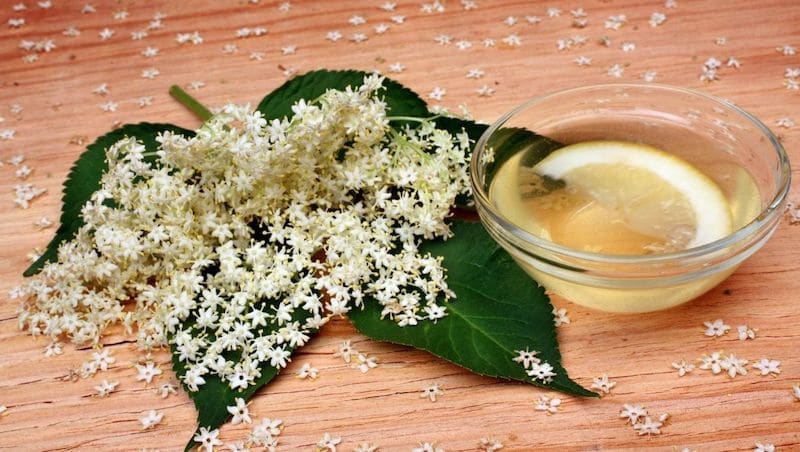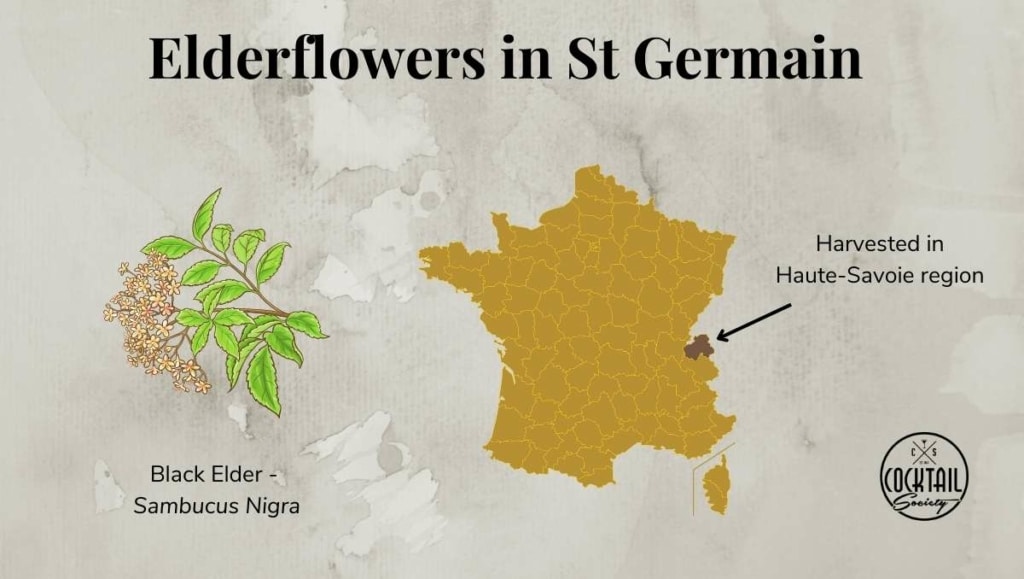St Germain liqueur (pronounced "Sang zhair-MANG") is a liqueur made from elderflowers, the small and white blossoms of the elderberry plant. It has a sweet and floral taste and is made of fresh, hand-picked elderflowers. Every bottle contains the natural taste of up to 1,000 of these blossoms.
The liqueur was released in 2007 by Rob Cooper, and it quickly became a favorite of bartenders to fix the flavor in cocktail recipes. That also got the liqueur its nickname - "bartender's ketchup".
The taste of elderflower is hard to describe. It's sweet and floral with hints of fruity notes. In Europe, these flowers are often used to make syrups, liqueur, and juice. And it was a cocktail made from elderflower syrup that gave Cooper the idea of making a liqueur with a similar flavor.
This liqueur is the secret weapon in many cocktail recipes. Read here what it is, how it tastes, and how you can use it in cocktails.
Taste
St Germain has a rich mouthfeel and texture with pronounced sweetness and subtle flavors. You get distinct floral notes from elderflower and honeysuckle paired with hints of pear and berries. Its consistency is thick, almost like syrup. By swirling, you can see how slow and smooth it moves around the glass.
How to drink St Germain?
You can drink St Germain any way you like: neat, on the rocks, with a mixer, or in cocktails. Due to its heavy sweetness, I recommend drinking it chilled and not at room temperature. That's because, at higher temperatures, the liqueur can be too thick and sweet. The best way to enjoy it is in Spritzes or other cocktails.
St Germain liqueur in cocktails
The sweet and floral taste of St Germain makes it an excellent ingredient in spring and summer cocktails. You can pair it with almost every base spirit, and it is also a perfect match for sparkling wine. But only in combination with citric flavors, the liqueur unfolds its full potential. Here are some popular recipes worth trying with St Germain Elderflower:
The best substitute for St Germain elderflower liqueur
The best substitute for St Germain liqueur is other elderflower liqueurs like Drillaud, Fiorente, or Giffard Fleur de Sureau Sauvage. Elderflower syrup is an excellent non-alcoholic alternative.
If an alternating flavor profile is okay, Italicus is another option to replace St Germain in a cocktail. Italicus is also intensely floral and often used in similar kinds of drinks. For me, it is an underrated alternative to elderflower liqueur.
What is St Germain liqueur made from?
The ingredients in St Germain include fresh elderflowers of the Sambucus nigra variety, sugar, and a grape spirit made from Chardonnay and Gamay grapes. The fresh elderflowers infuse the grape eau-de-vie before sugar is added to sweeten the liqueur. Per 1 liter of spirit, 180 grams of pure sugar are added.
Only fresh and fragrant elderflowers are used to flavor the base spirit. These flowers are hand-harvested in late springs from local farmers in Haute Savoie. The yellow-golden shade of the liqueur is achieved naturally due to the pollen.

Why is it called St Germain?
St Germain liqueur is from France, and it is the world's first commercially produced elderflower. It got its name from the fashionable quarter of St-Germain-des-Près located in Paris.
This neighborhood is one of the world's most important meeting places for artistic creation. St. Germain was once home to creative greats such as Pablo Picasso, Charles Baudelaire, and Ernest Hemingway.
How much does it cost?
St Germain is a medium-shelf liqueur and sells for $15 per 375ml bottle and around $35 for the 750ml bottle. In Europe, it tends to be slightly cheaper and often sells for less than $30.
History of the St Germain liqueur
Rob Cooper invented the liqueur in 2007, but the story of the liqueur started already six years before. One evening in 2001, New York-born Cooper went into a bar in London after a long day at work. He had a cocktail that contained elderflower syrup.
Copper had tried elderflower syrups before, but he found this fresh and fragrant infusion was different. Inspired by the drink in front of him, he started thinking about how to transport this fresh, fragrant, and floral taste into a liqueur.
Soon after, he tried to create an alcoholic product that captures this flavor - equally good as the syrup did. To focus on his elderflower liqueur, Rob Cooper had to leave the family business where he had been working up until then, and which produced and sold Chambord among others. -At least he remained within the industry.
It took almost six years until Cooper was able to launch his product. But as they say, good things take time. St Germain quickly became a staple in bars around the world.
In 2012, Cooper sold St. Germain to the Bacardi Group. Sadly, four years later, at only 39, he did in his Santa Barbara home.
Harvesting & Processing Elderflowers
First, he had to find the right place where Sambucus nigra - black elder- grows. He identified the French Savoy region as perfect for harvesting these precious flowers.

The problem was convincing friends and family that there was a big enough market for these flowers to operate profitably. Not even his father, a liqueur magnate himself, believed in the idea. Allegedly, he offered to hire him back once he had failed.
Processing the flowers turned out to be a nightmare. Pressing the pedals too hard created a bitter taste. Dehydrating or freezing them killed their aroma and flavor. The only way was to use freshly harvested blossoms and let them infuse in alcohol. But, in the end, Copper got it right and St. Germain became a tremendous success.
Drillaud elderflower liqueur vs. St Germain vs. Fiorente
All three liqueurs have an alcohol content of 20% (40 proof). Drillaud elderflower liqueur is significantly cheaper ($18) than St Germain ($30) and has a similar flavor profile. -It lacks a bit of sweetness and floral notes from elderflowers, though. Fiorente is a bit more affordable ($25) than St. Germain and has a fresher flavor profile with hints of mint and citrus.
Here's how the three elderflower liqueurs compare:
| St Germain | Drillaud | Fiorente | |
|---|---|---|---|
| Type | Elderflower liqueur | Elderflower liqueur | Elderflower liqueur |
| Origin | France | France | Italy |
| Owned by | Bacardi Group | Renaud-Cointreau Group | Distillerie Francoli |
| ABV | 20% | 20% | 20% |
| Proof | 40 | 40 | 40 |
| Price | $30 | $18 | $25 |
| Taste | Sweet, floral, fruity | fruity, less sweet, and less floral | Sweet, floral, fresh, citrusy |
St Germain Liqueur FAQs
Related Articles
Liqueurs are wonderful cocktail ingredients, and there are so many different ones to discover. Some of my favorites are:
- Safari liqueur - A fresh and tropical liqueur produced in the Netherlands
- Ancho Reyes - A spicy chile liqueur from Mexico available in two different styles.
- Maraschino liqueur - A beautiful cherry-flavored liqueur made of Marasca cherries.
- Blue Curacao - The famous blue liqueur coming from the Caribbean.
- Green Chartreuse - A traditional French herbal liqueur produced by the monks of the Chartreuse order.
- Or try Licorice liqueur. This liqueur has an almost syrupy consistent and a distinct licorice flavor.

